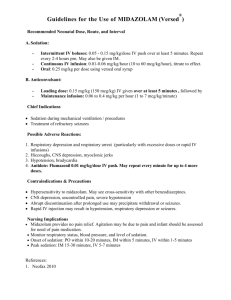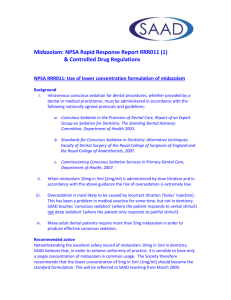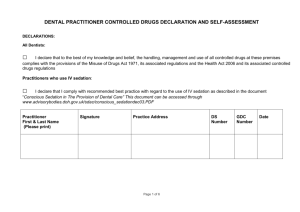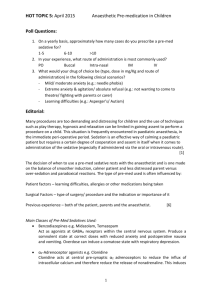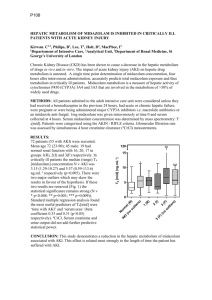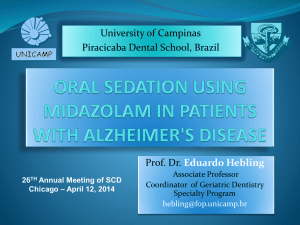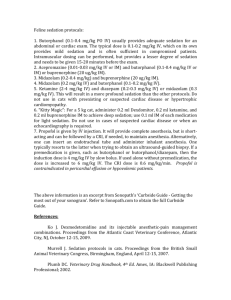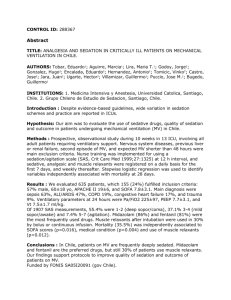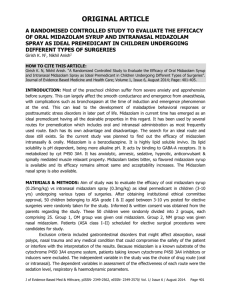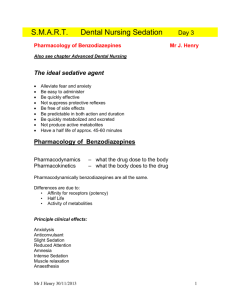REVIEW ARTICLE Midazolam: a review of its use for conscious
advertisement
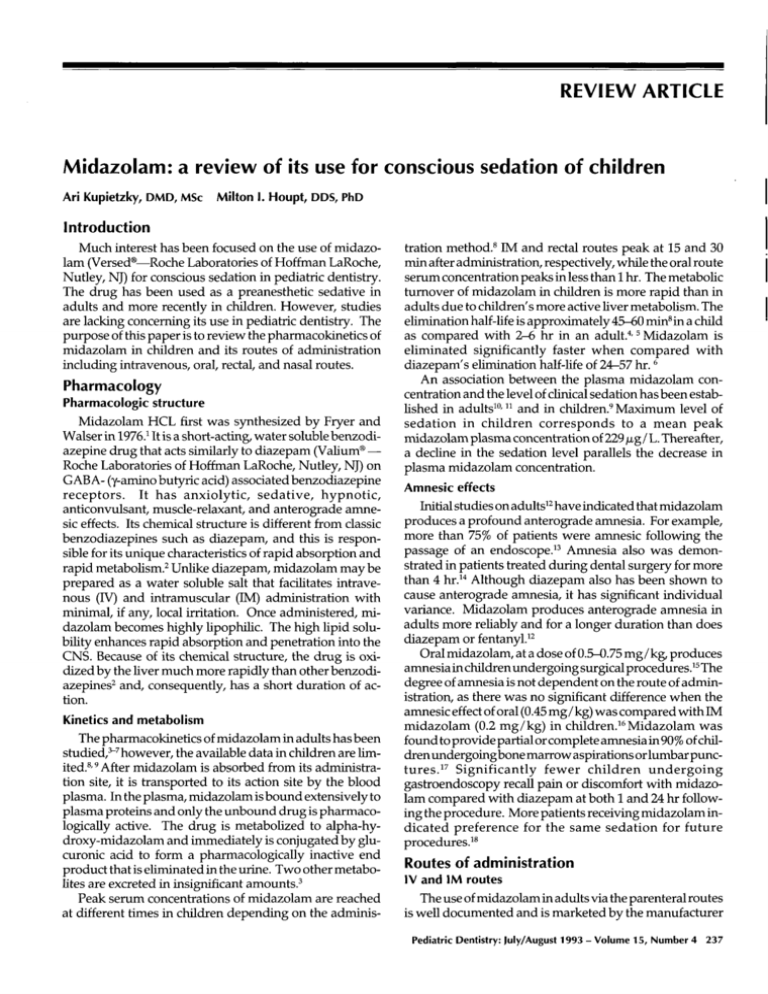
REVIEW ARTICLE Midazolam:a review of its use for conscioussedation of children Ari Kupietzky, DMD,MScMilton I. Houpt, DDS,PhD Introduction Muchinterest has been focused on the use of midazolam (Versed~Roche Laboratories of Hoffman LaRoche, Nutley, NJ) for conscious sedation in pediatric dentistry. The drug has been used as a preanesthetic sedative in adults and more recently in children. However, studies are lacking concerning its use in pediatric dentistry. The purpose of this paper is to review the pharmacokineticsof midazolamin children and its routes of administration including intravenous, oral rectal, and nasal routes. Pharmacology Pharmacologic structure Midazolam HCLfirst was synthesized by Fryer and Walserin 1976.1It is a short-acting, water soluble benzodi®azepine drug that acts similarly to diazepam (Vafium Roche Laboratories of HoffmanLaRoche, Nutley, NJ) on GABA-(y-amino butyric acid) associated benzodiazepine receptors. It has anxiolytic, sedative, hypnotic, anticonvulsant, muscle-relaxant, and anterograde amnesic effects. Its chemicalstructure is different fromclassic benzodiazepines such as diazepam, and this is responsible for its unique characteristics of rapid absorption and rapid metabolism. 2 Unlike diazepam, midazolam may be prepared as a water soluble salt that facilitates intravenous (IV) and intramuscular (IM) administration minimal if any, local irritation. Onceadministered, midazolam becomeshighly lipophilic. The high lipid solubility enhances rapid absorption and penetration into the CNS.Because of its chemical structure, the drug is oxidized by the liver muchmore rapidly than other benzodiazepines2 and, consequently, has a short duration of action. Kinetics and metabolism The pharmacokinetics of midazolamin adults has been studied, ~-7 however,the available data in children are limited.S, 9 After midazolamis absorbed from its administration site, it is transported to its action site by the blood plasma. In the plasma, midazolamis bound extensively to plasma proteins and only the unbounddrug is pharmacologically active. The drug is metabolized to alpha-hydroxy-midazolam and immediately is conjugated by glucuronic acid to form a pharmacologically inactive end product that is eliminated in the urine. Twoother metabo3lites are excreted in insignificant amounts. Peak serum concentrations of midazolam are reached at different times in children depending on the adminis- tration method,s IM and rectal routes peak at 15 and 30 min after administration, respectively, while the oral route serum concentration peaks in less than i hr. The metabolic turnover of midazolamin children is more rapid than in adults due to children’s more active fiver metabolism. The elimination haft-life is approximately45-60 minSina child as compared with 2-6 hr in an adult. 4, 5 Midazolamis eliminated significantly faster when compared with diazepam’selimination half-life of 24-57 hr. 6 An association between the plasma midazolam concentration and the level of clinical sedation has beenestabfished in adults 1°, 11 and in children. 9 Maximum level of sedation in children corresponds to a mean peak midazolamplasma concentration of 229/zg / L. Thereafter, a decline in the sedation level parallels the decrease in plasma midazolam concentration. Amnesic effects Initial studies on adults12 have indicated that midazolam produces a profound anterograde amnesia. For example, more than 75%of patients were amnesic following the passage of an endoscope23 Amnesia also was demonstrated in patients treated during dental surgery for more than 4 hr. 14 Although diazepam also has been shown to cause anterograde amnesia, it has significant individual variance. Midazolam produces anterograde amnesia in adults more reliably and for a longer duration than does 2diazepam or fentanyU Oral midazolam,at a dose of 0.5-0.75 mg/kg~produces amnesiain children undergoing surgical procedures.15 The degree of amnesiais not dependent on the route of administration, as there was no significant difference whenthe amnesiceffect of oral (0.45 mg/ kg) was comparedwith midazolam (0.2 mg/kg) in children.16Midazolam was found to provide partial or completeamnesiain 90%of children undergoing bone marrowaspirations or lumbar punctures. 17 Significantly fewer children undergoing gastroendoscopy recall pain or discomfort with midazolam compared with diazepam at both I and 24 hr following the procedure. Morepatients receiving midazolamindicated preference for the same sedation for future s procedttres2 Routes of administration |v and|M routes The use of midazolamin adults via the parenteral routes is well documentedand is marketed by the manufacturer Pediatric Dentistry: July/August1993 - Volume15, Number4 237 exclusively for 1V and IM use in adults. Whengiven parenterally, 19 midazolam is preferred to diazepam. Diazepam’sabsorption after IM injection is slow and er2°wher ratic eas and it is often associated with severe pain, midazolamis well-absorbed and is less painful via the IM route. Whenadministered intravenously, diazepam may cause phlebitis and local pain, whereas midazolamdoes not, due to its increased water solubility. The recommended dose for IV administration of midazolam is between 0.05-0.1 mg/kg, depending on the nature of the procedure (whether premedication, sedation, or general anesthesia induction) and whether other drugs are being used9,18,21(Table1). Table1. Common pediatric doses Route Dose mg/kg Intravenous Oral Rectal Nasal 0.05 - 0.1 0.3- 0.75 0.4- 1.0 0.2- 0.3" ¯ Repeatdoseafter 10 min if needed. Although the IV route is the mosteffectives, 9, is, 19,21it is not preferred for children. Parenteral administration is a major cause of anxiety, discomfort, and trauma in children and the trend in pediatrics is to avoid injections whenever possible. Consequently, other routes including the oral, rectal, and nasal routes have been used. Theoral route Midazolamcurrently is available in the United States only as an IV solution. It has beenused as an oral agent but it has a distinct bad taste that is not easily disguised in apple juice or other clear or carbonated liquids. Various homemadepreparations to mask the bad taste have been reported.S, 15, z2 Oneuseful methoduses a 2-quart package of grape flavored Kool-Aid® (Kraft General Foods, Inc., White Plains, NY)with Nutrasweet® (Nutrasweet, Skokie, IL) mixed in only 2 cups of water. ~3 The concentrated midazolarn (5 ml/mg) at 0.5 mg/kg then is mixed with 10 ml of the concentrated grape drink and refrigerated. This formulation takes the bitterness out of the parenteral preparation. Numerousstudies of oral midazolam in children have given conflicting results2s,16,2~,24A single oral dose of 0.2 mg/kgwas found to be effective during laceration repair in the emergency room.24 However, most studies indicated that a higher oral dose is needed,s,15,16, 2s Only15-30% of an orally administered dose reaches the systemic circulation in its nonmetabolizedform due to an extensive firstpass hepatic effect, s Thus, the oral dose should be approximately double or triple the IV dose to achieve similar clinical effects. Oral doses ranging between0.3-0.75 rag/ 8, is, 2~ to be given 20-30 kg commonlyare recommended rain prior to treatment. 238 Pediatric Dentistry: July/August1993 - Volume15, Number4 Therectal route Whereasoral administration requires patient cooperation, the rectal route does not. Children could be told that their temperature is being taken and frequently they will cooperate for the procedure. Most drugs, however, are 26 not as well-absorbedrectally as from the upper intestine. Rectal midazolam has been studied as a preanesthetic medication for children27, 2s and the optimal sedative dose was determined to be 1.0 mg/kg.27 Children receiving variable doses of rectal midazolam as high as 5 mg/kg were delayed in discharge from the hospital; however, only one of the 41 patients lost consciousness. Thenasal route The first study of intranasal administration of midazolamin children was conducted by Wilton in 198829 and other studies have been performedsince.3°-g7A dose of 0.2 mg/kg-0.3 mg/kg (5 mg/ml, IV solution) in a 1-ml syringe was given. If patients did not show significant sedation in 5 to 10 min, a repeat dose was administered. Higher doses necessitated a larger volume of the drug, resulting in more coughing, sneezing and expulsion of part of the drug. To avoid this problem, administration of 3R the drug was performed in two steps instead of one. Children sedated with intranasal midazolam are passive and moderately drowsy but usually do not fall completely asleep. The average time to peak plasma concentrations and maximaleffect is 10 min31, 32, 36 and recovery time is approximately 30 min, with the degree of the sedative 33 effect similar to that obtained with IM administration. Noincidence of significant respiratory depression, emesis, or oversedation has been reported and all vital signs including oxygen saturation remain stable during sedation. Intranasal midazolammay be used in combination with other drugs in diagnostic and short surgical procedures in children. One technique involved 0.2 mg/kg intranasal midazolam followed by 9.0 mg/kg ketamine administered rectally. ~° Cardiovascular stability was found to be excellent and no respiratory depression was evidenced. The mean recovery time was 40 min in this noninvasive method of deep sedation. Intranasal midazolamhas also been used in doses higher than 0.3 mg/kg for children undergoing ophthalmological examination.3s No local or general adverse reactions were observed. Midazolam is not FDAapproved for intranasal administrations; however,the available literature supports its use in that fashion. Studies of its use in conscious sedation Although midazolam has not been recommended for children by the manufacturer, the drug has been used effectively for brief invasive proceduresin children. A 0.2mg/kg oral dose was successful in children younger than 6 years old during laceration repair. 34 Wmidazolam(maximumdose 0.15 mg/kg) alone or in conjunction with an opioid offered effective sedation and amnesia during bone marrow aspirations and lumbar punctures. 17 IV midazo- lam (0.1-0.15 mg/kg) now has replaced diazepam as the first choice sedative agent for invasive endoscopicprocedures. 19 Intranasal midazolam(0.17 mg/kg) together with IM morphine allowed placement of a central venous catheter in a critically burnedchild. 38 It appears that midazolam maybe used effectively in pediatric patients for short, slightly painful and invasive procedures. For extremely painful treatment, an analgesic drug supplement may be required. Midazolam has been used together with opi3°, 39 but no study has reported its use oids17,3s and ketamine in conjunction with nitrous oxide. Adverse reactions The benzodiazepine group of drugs is one of the safest presently in use. Midazolamis virtually free of any side effects. The major risk associated with high doses of 17 midazolamis hypoventilation and associated hypoxemia. Respiratory depression has been reported in adults, 4° however, there have been few reports of depression in children. One reason for the numerousearly reports of apnea in adults was the initial dose guidelines that underestimated the relative potency of midazolam, which is now believed to be three- to four-times more potent than diaz19 epam--not twice as was originally thought. Respiratory depression developed in one patient who received IV midazolam and meperidine, however, it was not determined whether the complications were due to the meperidine, the midazolam, or a combination of the two drugs.21 Anothercase involved respiratory arrest in a 41 toddler who had received IV midazolarn and fentanyl. This complication appeared to be due to the excessive dose of fentanyl. It is advisable to monitor children receiving midazolam for early signs of hypoventilation or apnea. Respiratory depression appears to be dose related, 6,17 and dosageregimens should be strictly followed. Someauthors advise against routine use of concomitant administration of an opiate-like analgesic, whichcould both intensify respiratory depression19, 2~ and increase the likelihood of an adverse cardiopulmonary event. However, others use the combination without complicationY,38 In a study examining loss of consciousness in children, only one of 41 children receiving 0.4-5.0 mg/kg rectal midazolamlost conscionsness (4.5 mg/kg).27Decreasedoxygen saturation and depressed respiration were resolved with verbal stimulation, release of airway obstruction, and / or supply of positive pressure ventilation with oxygen. Whengiven in sedative doses without any additional medications, no clinically significant respiratory depression has been reported. Aninteresting report described tmconsciousness associated with the use of oral midazolam(0.5 mg/kg)with erythromycin (400 mg) given for antibiotic prophylaxis before adenoidectomy.42 The altered pharmacokinetics of midazolammayhave resulted from reduced hepatic clearance of midazolam by the erythromycin, an enzyme-inhibiting drug. Therefore, care should be exercised when using midazolamtogether with erythromycin. Other less commonadverse effects include: agitation, hyperactivity, combativeness, and involuntary movements.43 No longterm adverse effect has been reported. The relative safety of midazolamand lack of adverse effects maybe attributed to the drug’s selective rather than generalized CNSdepressant action. The sedative effect of midazolamis related to its occupation of the benzodiazepine receptor-enhancing GABA action. This effect of midazolam can be reversed by IV administration of flumazenil (MaziconWM--Roche Laboratories of Hoffman LaRoche,Nutley, NJ),~,4s and reversal of sedation occurs within a few minutes23 Due to midazolam’sshort half-life recurrence of sedation following reversal is not likely to occur. Routine use of flumazenil is not recommendedand should be reserved for emergencies only. Although the use of flumazenil has been reported in infants, pediatric dosage recommendations have not been made. Discussion Midazolam offers many advantages when compared with diazepam (Table 2). It is more water soluble and, thus, whengiven intravenously, it is less irritating and causes fewer adverse local vascular reactions and pain. Its distribution and elimination half-lives are muchshorter than with diazepam. The metabolites of diazepam are pharmacologically active while those of midazolam are not. These features facilitate the use of midazolamin a dental setting where the patient is expected to be discharged and sent home immediately after the sedationassisted procedure. The use of sedation in a pediatric patient is always an interim methodof managementallowing treatment to take place. Eventually the child is expected-through various managementtechniques--to "graduate" and receive further dental treatment without sedation. The pediatric patient who vividly remembersdental procedures like restraints (Papoose Board®--OlympicMedical Group, Seattle, WA),administration of local anesthesia, and complicated restorative treatment may become traumatized and be reluctant to return for further treatments. The level of amnesia achieved by a sedative agent is therefore of utmost importance. It has been shownthat midazolam produces anterograde amnesia more reliably 2and for a longer duration than diazepam2 The infant or preschool child presents additional challenges to the pediatric dentist as administering a sedative Table2. Clinical advantages of midazolam Water soluble Rapid onset Short acting Anticonvulsant, muscle relaxant Anterograde amnesia Clinically inactive metabolites Relatively high marginof safety Reversal agent available Maybe administered intranasally Pediatric Dentistry: July/August 1993 - Volume15, Number4 239 agent is frequently difficult. Althoughthe IV route is the most effective, it is not the preferred route in pediatric patients. Children generally fear injections, and the administration of an IV drug may be as traumatic to the apprehensive and anxious child as the dental treatment itseff. Hence,there has beena search for effective alternate routes. Oral administration of midazolam has many disadvantages. Midazolamhas a disagreeable taste that is difficult to mask.= Children may refuse to swallow and may expectorate part of the drug. The clinician then is uncertain howmuchmedication actually was ingested by the child. Oral agents tend to have a slow and variable onset and depth of sedation. They may cause nausea and have a relatively prolongedeffect. In addition, oral midazolamis absorbed via the gastrointestinal tract and passes through the portal circulation decreasingbioavallabillty of the drug. IV doses given orally are ineffective, and triple the IV dose s, 9,15 is required, The rectal route has been studied as an alternative to the parenteral and oral routes. This route was preferred since it was believed to be reliable, rapid, and virtually painless, but conflicting clinical results were found with this method.27, ~ Rectal absorption was found to be poor and irregular s and is the least reliable of all the routes studied. Furthermore, rectal administration maybe uncomfortable and embarrassing for the child. Incidence of rectal pain, itching, and intraoperative defecation have been reported. Although rectal administration has been popular in Europe, it has not found favor in Great Britain or the United States and is not recommended for use in the pediatric dental setting. Preliminary studies suggest that intranasal midazolam is an effective anxiolytic and sedative in infants and preschool children. 3°-37 The rapid onset of relatively high plasma concentrations obtained after intranasal administration of midazolamoffers significant advantages compared with the orally or rectally administered drug.34 The drug is particularly useful in the dental setting, allowing administration to occur just 10 min prior to treatment. Administrationis simple andrelativelypainless. Although intranasal administration maybe objectionable, less patient cooperation is required than with oral administration in which the child must swallow the medication. Nasal midazolam is absorbed from an area rich in blood supply, avoiding the disadvantage of passing through the portal circulation, thus increasing the bioavailabflity of the drug. It seems that nasal midazolam has all the advantages of IV administration without the disadvantages of pain and fear associated with intravenous injections. However,additional careful study is needed before concluding that nasal midazolamis the ideal sedative agent for use by pediatric dentists. The exact mechanismsof intranasal absorption of drugs is unknown.It is speculated that these drugs maybe absorbed into the brain and 4~ cerebrospinal fluid directly through the cribriform plate, and some drugs may achieve proportionately higher con240 Pediatric Dentistry: July/August1993 - Volume15, Number4 centrations within the brain when administered nasally than intravenously. Clhticians using this technique should proceed as cautiously as if the drug were being given intravenously. Another relative disadvantage of the nasal administration is its dependence on the nasal mucousmembranefor drug absorption, thereby permitting the commoncold to be a contraindication for its use. Other possible adverse effects to the nasal mucosa caused by long-term use of midazolamor its vehicle remain to be determined. The majority of the studies with children deal with induction into anesthesia or other examinations (echocardiographic, ophthalmologic). These procedures are relatively painless, noninvasive, of relatively short duration, and require only limited patient cooperation. In contrast, dental treatment often consists of a long procedure involving administration of local anesthetic and complicated restorative techniques necessitating total patient cooperation. The short duration of midazolamsedation is also of concern. For its incorporation into pediatric dentistry, a longer period of sedation is usually required and perhaps more than one dose will be necessary. Alternatively, a single dose maybeadequate when supplemented with nitrous oxide. All of the studies reviewed indicate the relative safety of midazolamin children regardless of its administration route. Whengiven in sedative doses, clinically important respiratory depression does not occur. However,as with all sedative agents, children must be observed carefully and dosage regimens strictly followed whenever midazolamis used. In the unlikely occurrence of respiratory depression, a reversal agent, flumazenil, is available and is effective. Future research should include study of the effects of intranasal midazolamtogether with nitrous oxide for sedation of children. In addition, the effectiveness and safety of multiple doses of intranasal midazolamfor prolonged sedative effect should be investigated. Summary Midazolamis a short-acting, water-soluble benzodiazepine. It has anxiolytic, sedative, hypnotic, anticonvulsant, muscle-relaxant, and anterograde amnesiceffects. The drug has been used as a preanesthetic sedative in adults, and more recently in children. This paper reviewed the pharmacokinetics of midazolamand its routes of administration in children. Intranasal administration was found to have manyadvantages including rapid onset of sedation, ease of administration, and safety. The use of intranasal midazolam together with nitrous oxide/oxygen for conscious sedation of children during dental treatment should be investigated. Dr. Kupietzky is a postdoctoral student and Dr. Houpt is professor and chairman, Department of Pediatric Dentistry,UMDNJ--NewJersey Dental School, Newark. 1. Walser A, Benjamin LE Sr, Flynn T, MasonC, Schwartz R, Fryer RI: Quinazolines and 1, 4-benzodiazepines. 84. Synthesis and 2. 3. 4. 5. 6. 7. 8. 9. 10. 11. 12. 13. 14. 15. 16. 17. 18. 19. 20. 21. 22. 23. 24. reactions of imidazo (1,5 -a) (1,4)-benzodiazepines. J Org 43:936-44, 1978. Gerecke M: Chemical structure and properties of midazolam compared with other benzodiazepines. Br J Clin Pharmacol 16(Suppl 1):11S-16S, 1983. Heizmann P, Eckert M, Ziegler WH: Pharmacokinetics and bioavailability of midazolamin man. Br J Clin Pharmaco116(Suppl 1):43S-49S, 1983. Greenblatt DJ, Abernethy DR, Locniskar A, Harmatz JS, Limjuco RA, Shader RI: Effect of age, gender, and obesity on midazolam kinetics. Anesthesiology 61:27-35, 1984. AllonenH, Ziegler G, Klotz U: Midazolamkinetics. Clin Pharmacol Ther 30:653-61, 1981. Reves JG, Fragen RJ, Vinik HR, Greenblatt DJ: Midazolam: Pharmacology and uses. Anesthesiology 62:310-24, 1985. Persson P, Nilsson A, Hartvig P, TamsenA: Pharmacokinetics of midazolamin total IV anaesthesia. Br J Anaesth 59:548-56, 1987. Payne K, Mattheyse FJ, Liebenberg D, DawesT: Pharmacokinetics of midazolam in paediatric patients. Eur J Clin Pharmacol 37:267-72, 1989. Tolia V, Brennan S, Aravind MK,Kauffman RE: Pharmacokinetic and pharmacodynamic study of midazolam in children during esophagogastroduodenoscopy. J Pediatr 119:467-71, 1991. Kanto J, Allonen H: Pharmacokinetics and the sedative effect of midazolam. Int J Clin Pharmacol Ther Toxicol 21:46~63, 1983. Crevoisier C, Ziegler WH,Eckert M, HeizmannP: Relationship between plasma concentration and effect of midazolamafter oral and intravenous administration. Br J Clin Pharmacol 16:(Suppl 1)51S-61S, 1983. Ochs MW,Tucker MR, White Jr RP: A comparison of amnesia in outpatients sedated with midazolam or diazepam alone or in combination with fentanyl during oral surgery. J AmDent Assoc 113:894-97, 1986. Pearson RC, McCloy RF, Morris P, Bardhan KD: Midazolam and flumazenil in gastroenterology. Acta Anaesthesiol Scand Suppl 92:214, 1990. Church JA, Pollock JSS, Still DM,Parbrook GD: Comparison of two techniques for sedation in dental surgery. Anaesthesia 46:78083, 1991. Feld LH, Negus JB, White PF: Oral midazolam preanesthetic medication in pediatric outpatients. Anesthesiology 73:831-34, 1990. Payne KA, Coetzee AR, Mattheyse FJ: Midazolam and amnesia in pediatric premedication. Acta Anaesthiol Belg 42:101-5, 1991. Sievers TD, Yee JD, Foley ME,Blanding PJ, Berde CB: Midazolam for conscious sedation during pediatric oncology procedures: safety and recovery parameters. Pediatrics 88:1172-79, 1991. Tolia V, Fleming SL, Kauffman RE: Randomized, double-blind trial of midazolam and diazepam for endoscopic sedation in children. Dev Pharmacol Ther 14:141-47, 1990. McCloyRF, Pearson RC: Which agent and how to deliver it? A review of benzodiazepine sedation and its reversalin endoscopy. Scand J Gastroenterol Suppl 179:7-11, 1990. Bergman SA, Wynn RL, Roth-Schechter BF, Requa-Clark B, Holroyd SV: The benzodiazepines, sedative-hypnotics, and central muscle relaxants. In Clinical Pharmacologyin Dental Practice, 4th Ed. SV Holroyd, RL Wynn, B Requa-Clark, EDS. St. Louis: CVMosbyCo, 1988, pp 82-90. Diament MJ, Stanley P: The use of midazolam for sedation of infants and children. AmJ Roentgeno1150:377-78, 1988. Anderson BJ, Exarchos H, Lee K, BrownTCK:Oral premedication in children: A comparison of chloral hydrate, diazepam, alprazolam, midazolam and placebo for day surgery. Anaesth Intensive Care 18:185-93, 1990. Peterson MD:Making oral midazolam palatable for children. [Letter] Anesthesiology 73:1053, 1990. Hermes HM, Wagner V, Bonadio WA, Glaeser PW, Losek JD, Walsh-Kelly CM, Smith DS: The effect of oral midazolam on 25. 26. 27. 28. 29. 30. 31. 32. 33. 34. 35. 36. 37. 38. 39. 40. 41. 42. 43. 44. 45. 46. anxiety of preschool children during laceration repair. AnnEmerg Med19:1006-9, 1990. Silver TC: Evaluation of oral midazolam sedation for pediatric dental patients. Pediatr Dent abst. 14:413, 1992. WynnRL: General principles of drug action. In Clinical Pharmacology in Dental Practice, 4th Ed. SV Holroyd, RL Wynn, B Requa-Clark, EDS. St. Louis: CVMosbyCo, 1988, pp 12. Spear RM, Yaster M, Berkowitz ID, Maxwell LG, Bender KS, Naclerio R, Manolio TA, Nichols DG:Preinduction of anesthesia in children with rectally administered midazolam. Anesthesiology 74:670-74, 1991. Roelofse JA, Van der Bijl P, Stegmann DH, Hartshorne JE: Preanesthetic medication with rectal midazolam in children undergoing dental extractions. J Oral Maxillofac Surg48:791-96,1990. Wilton NCT,Leigh J, Rosen DR, Pandit UA:Preanesthetic sedation of preschool children using intranasal midazolam. Anesthesiology 69:972-75, 1988. Saint-Maurice C, Landais A, Delleur MM,Esteve C, MacGeeK, Murat I: The use of midazolam in diagnostic and short surgical procedures in children. Acta Anaesthesiol Scand Supp192:39-41, 1990. Rose E, Simon D, Haberer JP: Premedication with intranasal midazolam in pediatric anesthesia. AnnFr Anesth Reanim9:32630, 1990 (French). Latson LA, Cheatham JP, Gumbiner CH, Kugler JD, Danford DA, Hofschire PJ, Honts J: Midazolam nose drops for outpatient echocardiography sedation in infants. AmHeart J 121:209-10, 1991. de Santos P, Chabas E, Valero R, Nalda MA:Comparison of intramuscular and intranasal premedication with midazolam in children. Rev Esp Anestesiol Reanim38:12-15, 1991 (Spanish). Walbergh EJ, Wills RJ, Eckhert J: Plasma concentrations of midazolamin children following intranasal administration. Anesthesiology 74:233-35, 1991. GobeauxD, Sardnal F, Cohn H, Lequoy O: Intranasal midazolam in pediatric ophthalmology. Cah Anesthesiol 39:34--6, 1991 (French). Bunz R, Gossler M: Intranasal premedication of young children using midazolam (Dormicum): Clinical experience. Anasthesiol Intensivmed Notfallmed Schmerzther 26:76-8, 1991 (German). Karl HW, Keifer AT, Rosenberger JL, Larach MG,Ruffle JM: Comparisonof the safety and efficacy of intranasal midazolamor sufentanil for preinduction of anesthesia in pediatric patients. Anesthesiology 76:209-15, 1992. Rice TL, Kyff JV: Intranasal administration of midazolam to a severely burned child. Burns 16:307-8, 1990. Van der Bijl P, Roelofse JA, Stander IA: Rectal ketamine and midazolam for premedication in pediatric dentistry. J Oral Maxillofac Surg 49:1050-54, 1991. Lewis JH, Benjamin SB: Safety of midazolam and diazepam for conscious sedation. [Letter] J Clin Gastroentero112:716-17, 1990. Yaster M, Nichols DG, Deshpande JK, Wetzel RC: Midazolamfentanyl intravenous sedation in children: Case report of respiratory arrest. Pediatrics 86:463-66, 1990. Hiller A, Olkkola KT, Isohanni P, Saarnivaara L: Unconsciousness associated with midazolam and erythromycin. Br J Anaesth 65:826-28, 1990. Versed. In Physicians Desk Reference, Montvale, NewJersey: Medical Economics. Data, 1992, pp 1924-26. Davies CA, Sealey CM, Lawson JIM, Grant IS: Reversal of midazolam sedation with flumazenil following conservative dentistry. J Dent 18:113-18, 1990. Collins S, Carter JA: Resedation after bolus administration of midazolamto an infant andits reversal by flumazenil. Anaesthesia 46:471-72, 1991. Hussain AA: Mechanismof nasal absorption of drugs. Prog Clin Biol Res 292:261-72, 1989. Pediatric Dentistry: July/August1993- Volume15, Number 4 241
